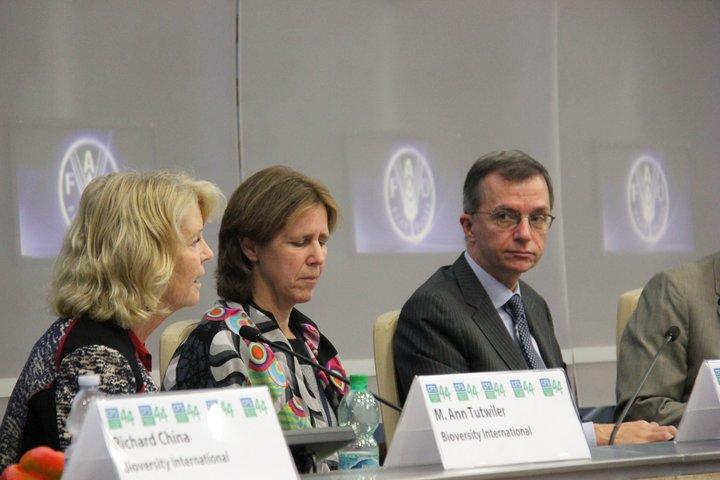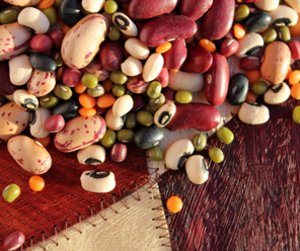Agrobiodiversity is essential for the disruptive changes we need in global food systems

On World Food Day, Ann Tutwiler, Director General, Bioversity International reflects on last week’s 44th Session of the Committee on World Food Security (CFS44) in Rome, Italy.
On World Food Day, Ann Tutwiler, Director General, Bioversity International reflects on last week’s 44th Session of the Committee on World Food Security (CFS44) in Rome, Italy, and on the crucial role agrobiodiversity needs to play in making a disruptive change to broken food systems.
Last week, at the Committee on World Food Security here in Rome, Italy, we heard a stark warning from the experts who produced the Nutrition and Food Systems Report.
“Carrying out superficial repairs to our existing food systems will no longer suffice. We need disruptive change within and across today’s varied and complex food systems.”
That disruptive change will have to include agricultural biodiversity. Of course agricultural biodiversity is not all that food systems need to be sustainable. But without it, no food system can be sustainable.
Historically, people have eaten about 7000 plant species and 40 kinds of animals. That diversity has been the basis of good nutrition and productivity in the many and varied environments that people have called home. Yet today, just 12 crops and 5 animal species dominate food systems worldwide.
Bioversity International’s new flagship publication brings together all the recent evidence on how agricultural biodiversity can help to make food systems more sustainable, and one of the key conclusions to emerge is that it’s complicated. Many pieces of a difficult puzzle need to fit together. I strongly believe that our new book Mainstreaming Agrobiodiversity in Sustainable Food Systems: Foundations for an Agrobiodiversity Index offers a series of vital clues to all those who need to solve the puzzle of sustainable food systems.
We launched the book at the Committee on World Food Security precisely because its pages deal with so many issues crucial to food security in the world. There are so many examples in the book, it is hard to pick a few.
 For nutrition, a single banana of the variety To’o gives women and children all the vitamin A they need each day. To get the same vitamin A from Cavendish, the banana variety that dominates supermarket shelves, they would need to eat a kilogram. Fruit trees, pulses, vegetables, cereals and small livestock, including fish, can be combined in a portfolio adapted to a specific environment that will provide a healthy, nutritious diet all year round.
For nutrition, a single banana of the variety To’o gives women and children all the vitamin A they need each day. To get the same vitamin A from Cavendish, the banana variety that dominates supermarket shelves, they would need to eat a kilogram. Fruit trees, pulses, vegetables, cereals and small livestock, including fish, can be combined in a portfolio adapted to a specific environment that will provide a healthy, nutritious diet all year round.
Sustainability is enhanced in more diverse systems. Soil carbon, for example, can be doubled in high-diversity farming systems. Diversified systems deliver higher yields, up by 22% in a diversified soybean system. Pests and diseases can be better managed with agricultural biodiversity than with synthetic pesticides. In Uganda, for example, adding traditional, disease-resistant varieties into a plot of beans reduced overall disease levels.
Seed systems, and especially the formal seed sector, do not currently support agricultural biodiversity. Although mainstream research released some 8,000 new varieties between 1960 and 2010, those covered only 11 crops, ignoring all the other highly nutritious crops. Many breeding efforts are geared towards yield alone, ignoring crucial factors such as nutrition and taste.
And of course, the genetic diversity of crops, trees and animals is one resource that is best conserved by making use of it.
 Speaking at the launch of the book, our guest Ambassador Pierfrancesco Sacco, Permanent Representative of the Italian Republic to the UN Agencies in Rome, said: “We will not be able to achieve Zero Hunger as well as many other interconnected Sustainable Development Goals unless agrobiodiversity is seriously taken on board. Why? Because it is crystal clear that agriculture in the last century has been very costly to human and environmental health, especially in terms of land degradation and loss of biodiversity.”
Speaking at the launch of the book, our guest Ambassador Pierfrancesco Sacco, Permanent Representative of the Italian Republic to the UN Agencies in Rome, said: “We will not be able to achieve Zero Hunger as well as many other interconnected Sustainable Development Goals unless agrobiodiversity is seriously taken on board. Why? Because it is crystal clear that agriculture in the last century has been very costly to human and environmental health, especially in terms of land degradation and loss of biodiversity.”
A key part of the puzzle remains: how do we manage something we do not currently measure? The book tackles that too. Bioversity International has developed an Agrobiodiversity Index that offers a consistent, long-term instrument to monitor and measure agricultural biodiversity across three crucial sectors; diet, production and genetic resources. With it, companies, countries and even consumers will find it easier to decide which among several options offers the greatest resilience and sustainability.
As Ambassador Sacco noted, “the continuation as business as usual of the 20th century model of agriculture presents increasing risks not only to the sustainability of food supply chains but also to our society at large”.
Thankfully, business is starting to change. I took part in many different events during the past week and was heartened to see some other initiatives aiming to mainstream tree and crop diversity in areas that are crucial for food and nutrition security. These included sessions around forests and food security, seed systems, nutrition and a new initiative from ICRISAT on Smart Food, which aims to promote currently neglected crops as staples for more sustainable food systems.
These changes will definitely disrupt today’s food systems. That is exactly what we need, because the result will be food systems that are nutritious, sustainable and equitable, built—like agriculture itself—on a solid foundation of agrobiodiversity.
M. Ann Tutwiler
Bioversity International participated as organizers or co-organizers with partners at three side-events during CFS44 showcasing: the launch of the Mainstreaming Agrobiodiversity in Sustainable Food Systems: Scientific Foundations for an Agrobiodiversity Index book; Strengthening Smallholder Seed Enterprises for Food, Nutrition and Income Security, and the launch of the Global Programme on Fusarium wilt. Find out more - https://www.bioversityinternational.org/cfs44/
Photos:
Top: (l-r) M. Ann Tutwiler, Director General, Bioversity International, Stineke Oenema, Coordinator of the United Nations System Standing Committee on Nutrition and Ambassador Sacco, Permanent Representative of the Italian Republic to the UN Agencies in Rome
Bottom: (l-r), Richard China, Director Strategic Partnerships and External Engagement, Bioversity International, M. Ann Tutwiler, Director General, Bioversity International, Stineke Oenema, Coordinator of the United Nations System Standing Committee on Nutrition, Juan Gonzalez-Valero, Head of Public Policy and Sustainability, Syngenta, Ambassador Mario Arriola, Alternate to the Permanent Representative of Mexico to the Rome-based Agencies, Ambassador Sacco, Permanent Representative of the Italian Republic to the UN Agencies in Rome Willem Olthof – Development Advisor, European Union.
Event photos taken at the launch of the Mainstreaming Agrobiodiversity in Sustainable Food Systems, at CFS44, October 11. Credits: Bioversity International/P. Gallo
Middle: Assorted beans and pulses. Credit: Bioversity International/C. Zanzanaini
